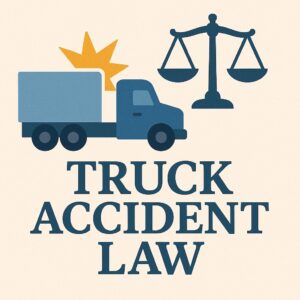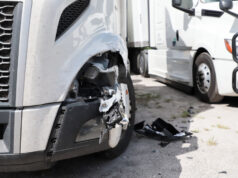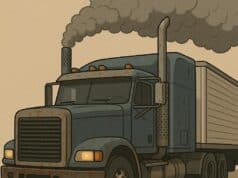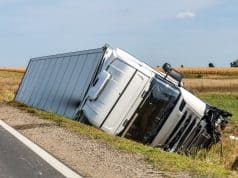Key Takeaways:
- Immediate safety and health checks are the top priority after a truck accident.
- Contacting emergency services, documenting the scene, and exchanging information are crucial next steps.
- You must report the accident to the authorities and your insurance company immediately.
- Seeking medical attention and tracking all records supports your recovery and necessary follow-up.
- Careful documentation and following proper procedures can help protect your rights and interests.
Table of Contents:
- Introduction
- Ensure Safety and Check for Injuries
- Contact Emergency Services
- Move to a Safe Location
- Document the Accident Scene
- Exchange Information with Involved Parties
- Report the Accident to Authorities
- Seek Medical Attention Promptly
- Notify Your Insurance Company
- Conclusion
Introduction
Accidents involving large trucks are rarely minor events. Due to the size and weight of commercial vehicles, collisions often result in extensive property damage and a significant risk of injury to all parties involved. Knowing what steps to take in the immediate aftermath of a truck accident can help you stay organized, protect your well-being, and stand up for your rights. The actions taken during the first few minutes are critical, creating a foundation for recovery and resolution. This guide outlines the essential steps to prioritize safety, gather key information, and navigate the process confidently.

Ensure Safety and Check for Injuries
When a truck accident occurs, the first step is to take a deep breath and quickly assess the situation. Your safety and the safety of others around you must come before anything else. Make a quick mental check of yourself for any pain, bleeding, or signs of injury, and look to others in your vehicle and any other parties involved. Even if you do not feel pain right away, adrenaline and shock can mask serious injuries. If you can, ask if others need help, and determine whether anyone is unresponsive or needs urgent medical attention. Stay as calm as possible and avoid sudden movements that could exacerbate injuries. For any questions about liability or your next legal steps, some people consult resources such as a Vero Beach truck accident lawyer. However, your immediate concern should always be safety and medical care.
Contact Emergency Services
Call emergency services immediately once you have determined your well-being, and check for injuries among all parties. Even minor accidents can cause not immediately noticeable injuries, so it is always best to have professional responders assess the scene. Dial the emergency number and provide your location, mentioning any visible hazards such as leaking fluids or blocked lanes. The presence of law enforcement and medical personnel ensures that anyone needing urgent care gets attention immediately and that the accident scene is documented accurately. Responders may also direct traffic, set up barriers, and assess vehicle safety to prevent further harm. Do not attempt to move anyone seriously injured unless there is an immediate risk, such as fire or oncoming traffic.
Move to a Safe Location
If vehicles are operational and safe, move your vehicle and any involved vehicles off the road to prevent further collisions. Turn on hazard lights to alert other motorists to your situation. Keeping away from the active roadway minimizes the risk of a secondary impact, especially on highways or busy streets. However, if a vehicle cannot be moved or injuries prevent relocation, make yourself as visible as possible using flares, reflective triangles, or flashlights. Stand in a safe spot off the road and away from traffic flow. Remaining at the scene is essential for your safety, gathering information, and addressing emergency responders’ questions.
Document the Accident Scene
When conditions are safe and you can move, document the accident scene thoroughly. Use your cell phone or a camera to take photographs and videos of all vehicles, skid marks, property damage, debris, and the surrounding area. Capture images from multiple angles, including close-ups of damage and wide shots to show vehicle positions. Make note of road signs, traffic signals, weather conditions, and other relevant details such as construction zones or obscured sightlines. Carefully record the license plates of all vehicles involved and any identifying features like company logos on trucks or trailers. If there are traffic cameras or businesses nearby that might have recorded the accident, take note of their locations. Written notes about what you remember, the time of day, and the order of events will be helpful for your reference and when making statements later.
Exchange Information with Involved Parties
After ensuring everyone’s safety and alerting authorities, exchange essential information with drivers, passengers, and witnesses. This typically includes full names, contact details, driver’s license numbers, and insurance information. For trucks, collect the name and contact information of the employing company and the vehicle’s registration and plate number. Get the owner’s details if the driver is not the owner. Additionally, information must be gathered from eyewitnesses on the scene, including bystanders and other motorists, as their perspectives may clarify fault or circumstances. Remain courteous and cooperative throughout the process, and avoid making statements about responsibility or assigning blame. Your words may be documented for investigative purposes, so be concise and factual.
Report the Accident to Authorities
A formal accident report is required in most truck accident cases, especially if injuries, fatalities, or property damage occur. When law enforcement arrives, cooperation occurs entirely by answering their questions honestly and providing identification and insurance. Officers will create an official report, take measurements, gather statements, and sometimes issue citations if laws were violated. Ask for the name and badge number of responding officers and request a copy or report number for your records. This document is a key reference for insurance claims and other follow-up matters. If the police do not respond to the scene, visit the nearest police station to file your report as soon as possible.
Seek Medical Attention Promptly
Even if no injuries are immediately apparent, seeking medical evaluation after any truck accident is essential. Symptoms of injury, such as whiplash, concussions, or internal trauma, may not become evident for hours or even days. Prompt consultation with a healthcare provider ensures that any conditions are diagnosed early, which helps with treatment and documentation for insurance or legal purposes. Be thorough in describing all symptoms, even if they seem minor. Keep copies of all medical evaluations, treatments, prescriptions, and receipts. Follow your doctor’s recommendations for ongoing care, therapy, or follow-up appointments. Delays in seeking medical attention can impact your recovery and create complications during the claims process.
Notify Your Insurance Company
After ensuring your immediate well-being, begin the recovery process, and contact your insurance company to report the accident as soon as possible. Provide a summary of the events, including time, location, parties involved, and any injuries or property damage sustained. Forward copies of photos, the police report, contact information from the other parties, and all medical records as requested by your insurer. Answer all questions honestly, but be cautious about making assumptions regarding fault until all facts are known. Your insurance adjuster will guide you through the claims process and may request additional documentation as your case is evaluated. Maintain an organized file of all correspondence, claim numbers, and paperwork for your records. You maximize your chances for a fair and efficient resolution by staying proactive and detail-oriented.
Conclusion
The moments immediately following a truck accident are often chaotic, but they are critical for ensuring safety, gathering vital information, and setting the stage for recovery. You can protect yourself and others by staying calm, prioritizing medical needs, and following the proper procedures. Documentation, open communication with authorities, and prompt notification of your insurance provider are essential steps that ease the aftermath of an accident. Ultimately, being prepared and informed empowers you to face such situations confidently, ensuring that your health is safeguarded every step of the way.






